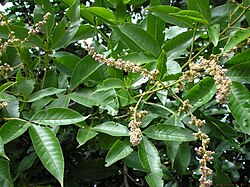Top Qs
Timeline
Chat
Perspective
Vitex
Genus of flowering plants in the sage family Lamiaceae From Wikipedia, the free encyclopedia
Remove ads
Vitex is a genus of flowering plants in the family Lamiaceae. It has about 200–250 species; as of August 2025[update] the Plants of the World Online database accepts 211 species.[1][3][4] Common names include chaste tree or chastetree, traditionally referring to V. agnus-castus, but often applied to other species, as well, and pūriri for the New Zealand species V. lucens.
Species of Vitex are native throughout the tropics and subtropics, with a few species in warm-temperate Eurasia and one in New Zealand.[2][5]
A number species are grown in cultivation. V. agnus-castus and V. negundo are the species most often planted in warm temperate European gardens;[6] several others are frequently grown in the tropics.[7] Most of the cultivated species serve as ornamental plants. Some provide valuable timber. The flexible twigs of some species are used in basket weaving.[5] Some of the aromatic species are used medicinally[7][8] or to repel mosquitos.[7]
The genus Vitex was named by Linnaeus in Species Plantarum in 1753.[9] Vitex was the name used by Pliny the Elder for V. agnus-castus. It is derived from the Latin vieo, meaning to weave or to tie up, a reference to the use of V. agnus-castus in basketry.[10]
As a result of phylogenetic studies of DNA sequences, Vitex is one of several genera that were transferred from the Verbenaceae to the Lamiaceae in the 1990s. It is the largest genus in the subfamily Viticoideae of Lamiaceae.[3] Taxon sampling in molecular phylogenetic studies has never been sufficient to test the monophyly of the Viticoideae, but it is generally thought to be an unnatural group.[11] The subfamily is probably diphyletic, with Premna, Gmelina, and Cornutia constituting one clade, and with Vitex, Petitia, Pseudocarpidium, and Teijsmanniodendron constituting the other.[12]
Remove ads
Description
Vitex is a genus of shrubs and trees, from 1–40 m tall.[6] Some species have whitish bark that is characteristically furrowed. The leaves are opposite, usually palmately compound, with three to seven leaflets; a few have simple leaves. Most are evergreen, but a few, including V. agnus-castus and V. negundo, are deciduous; some have scented foliage.[6] The flowers can be white, yellow, or violet, depending on the species; they are fragrant, and produced in terminal branched spikes or panicles.[6] The fruit is a fleshy red, purple, or black drupe.[6][13]
Remove ads
Circumscription
The type species is Vitex agnus-castus.[14] In 2009, a molecular phylogenetic study showed that three small genera, Paravitex, Viticipremna, and Tsoongia, are embedded in Vitex. These three genera were duly sunk into synonymy with Vitex.[12]
Pseudocarpidium, Petitia, and Teijsmanniodendron possibly are nested within Vitex. Sampling in the 2009 study was not sufficient to determine the phylogenetic position of these genera. The relationships of Teijsmanniodendron to these genera was not discussed in a revision of Teijsmanniodendron in 2009.[15]
Remove ads
Selected species
- Vitex acunae
- Vitex agnus-castus — chaste tree, chaste berry, monk's pepper
- Vitex ajugaeflora
- Vitex altissima
- Vitex amaniensis
- Vitex capitata
- Vitex chrysocarpa
- Vitex cofassus
- Vitex cooperi
- Vitex cymosa
- Vitex divaricata
- Vitex doniana — wild African black plum, koronfinfin
- Vitex evoluta
- Vitex gaumeri
- Vitex gigantea
- Vitex heptaphylla
- Vitex keniensis — Meru oak
- Vitex kuylenii
- Vitex lehmbachii
- Vitex leucoxylon
- Vitex lignum-vitae — yellow hollywood, lignum-vitae
- Vitex lindenii
- Vitex longisepala
- Vitex lucens — pūriri
- Vitex megapotamica
- Vitex negundo — five-leaf chastetree
- Vitex obovata
- Vitex orinocensis
- Vitex parviflora — Molave tree
- Vitex peduncularis
- Vitex pinnata
- Vitex quinata
- Vitex rotundifolia — beach vitex
- Vitex thyrsiflora
- Vitex triflora
- Vitex trifolia — simpleleaf chastetree
- Vitex tripinnata
- Vitex urceolata
- Vitex yaundensis
- Vitex zanzibarensis
- Vitex zeyheri


References
Further reading
External links
Wikiwand - on
Seamless Wikipedia browsing. On steroids.
Remove ads

